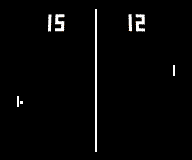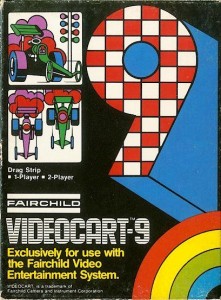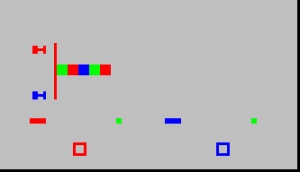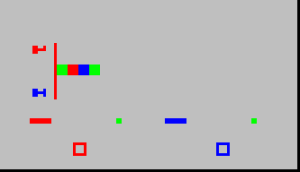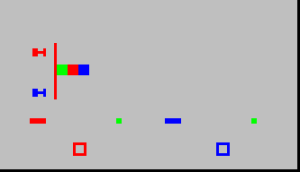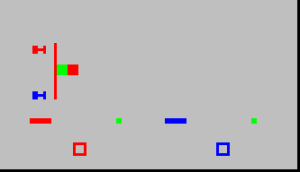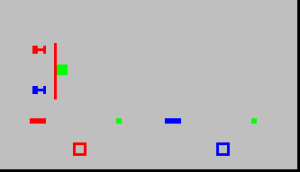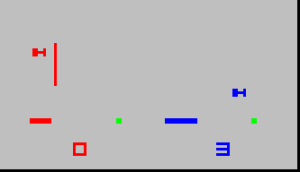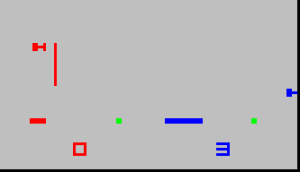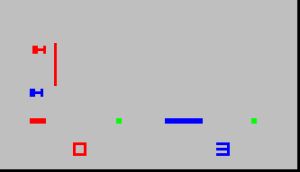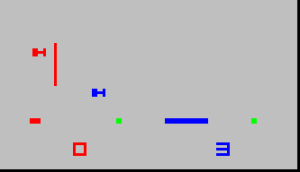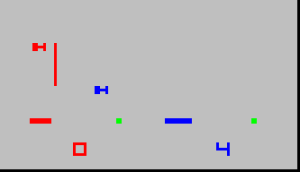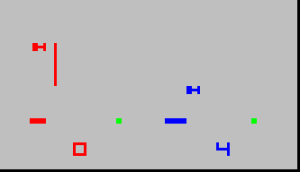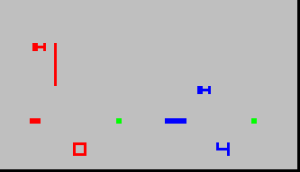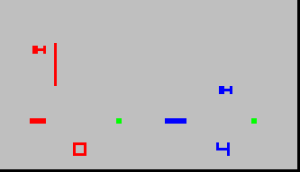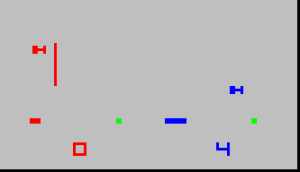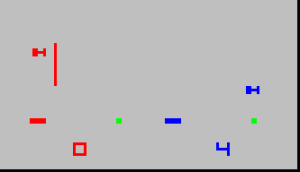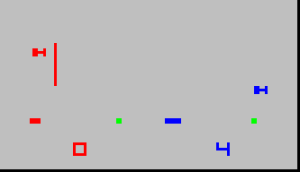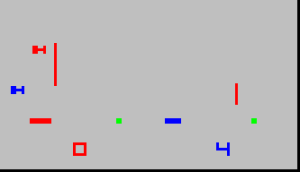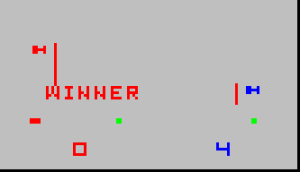Something else happened in 1972… the same year that the Odyssey had roused just about as much interest in this new “video game” phenomenon as it could have on its own. Atari invented Pong.
Well, Nolan Bushnell kind of stole it from the Odyssey’s game “Tennis”. That’s okay because everybody else in the mid ’70s stole the idea too and brought us the first video game crash. But I’m getting off topic. The reason I mention Pong is because it popularized the notion of video games to most people. By 1975, home versions of Pong (aka Pong consoles) were big sellers and allowed people to play the game on their own TVs. This opened up the market for electronics companies to do more with the technology at their disposal.
And in 1976, Fairchild Semiconductor used their (at the time) advanced 8-bit microprocessor to bring the world the Fairchild Channel F. This was not only the first microprocessor-based video game console, but the very first cartridge-based console. It may appear that the Odyssey had cartridges first, but a distinction must be made because those Odyssey carts were more like switches that set different play modes within the console itself. The Channel F was the first with actual ROM cartridges, where the game code resides in the cartridge.
And for the time, the Channel F was much better than its competition. This didn’t last long at all (see Atari), but it boasted 8 colours and sound! Add the theorized ability to make an indefinite number of games for the system, and you would think that Fairchild would be laughing all the way to the bank. But again, see Atari.
By today’s standards, the Channel F is primitive. The games for the system are fully realized, however. No overlays or cards or boards or dice are needed. The processor was rather underpowered considering the work it had to do, but it was powerful enough to allow for computer AI. This allows some games to be played against the computer instead of against a human Player 2.
Since the console didn’t have a long life-span, not much was done with it, and there aren’t many reasons to go out and get one. Unless you really like Pong, because with the analog joystick controller the Channel F had, the Pong clone built-into the system (called “Tennis”) is one of the best you can play.
And just to show off what could be done with the hardware, in 2004 someone made a homebrew version of the game Pac-Man for the Channel F. It is doubtless the best looking and sounding Channel F game in existence, and it even puts the Atari 2600 version of Pac-Man to shame.
Before I begin talking about the racing game that brought us all here, I want to say a few things about the emulator I used to play it. MESS is a noble endeavor and quite an ambitious project. The name says what it’s trying to do: Multi Emulator Super System. It’s an off-shoot of the well-known and loved MAME (Multiple Arcade Machine Emulator) project.
MESS emulates not just one or two or even a handful of systems, but hundreds. With a focus like that, it’s the only way that I know of to play games for rare consoles like the Channel F. But because it specializes in none of these systems, there are some limitations to how well MESS performs.
And when I talk about MESS, I’m talking about a very old version of MESS that I keep and use. The version I use is version .37b1, and it was released way back in August 2001. I’ve tried more recent versions over the years, but they only seem to break functionality with the systems that I use MESS to emulate. I tried the most recent version only to find that the developers have completely gutted the interface and taken away all but a handful of settings and options. I really hate it when people do this to software, but I’m very glad that I have a pack-rat mentality when it comes to the programs and files I’ve downloaded for use on my computers.
Unless someone decides to program a dedicated Channel F emulator, I’m going to be stuck using MESS.
Now, onward to the racing game.
Drag Strip (1976)
As far as I am aware, this is the first racing game for a home console. And it isn’t much. If you watched the Pac-Man video above, forget about anything looking or sounding that good. Like most Channel F games, you start with a mostly blank screen except for a “G?”, then “M?”, then “S?”. I think this means “Game”, “Mode” and “Start”. Not very elegant, but they probably faced all kinds of memory restrictions and needed to trim things wherever they could.
Starting the actual game gets you this lovely view:
The red and blue blocky things on the left of the screen are cars, and Player 1 is blue. Player 2 is red, and this game’s code is too complicated for the Channel F to take over duties as Player 2. So unless you have someone willing to indulge in this glorious display with you, it won’t be much of a race.
You can see that the multi-coloured bar between the cars and across the starting line has started to count down. You’ll also see some nasty flicker effects on the red car. I don’t know if this is the game’s fault or the emulator’s fault.
Anyway, the red and blue zeros at the bottom are indicators of the car’s current “gear”.
The red and blue lines above those are speed meters.
I don’t know much about drag racing or engines or gears, but you can blow your engine in this game if you push it past that green dot at the end.
And I’m off! In third gear, though I sometimes reach fourth. I can’t figure out how to control this thing properly, and again I don’t know if it’s the game or the emulator.
I don’t think there’s any steering involved, though the car will randomly move “left” and “right” as it races.
And as you can see I’ve scrolled around to appear on the other side of the screen.
This is exciting, isn’t it? I can only get sound to work in my emulator for this game some of the time, and this isn’t one of them. I’m not missing much.
Oh look, fourth gear! I still don’t really know how to coordinate top speed and fourth gear though.
Still racing along. I think the screen scrolls by about ten or so times in this race.
Are you as excited as I am?
These many screenshots accurately convey what playing this game is like. I suppose if Player 2 was active, it would be different.
Damn, Player 1 is standing still even slower!
I swear I was able to push my car faster the last time I played.
I know the end must be in sight…
Oh there it is. That red line. Here I come!
Wow, that was glorious.
So that’s one of the very first racing video games. I’d need to play this with a friend on an actual Channel F to know whether or not this could be any fun, but I think that it just might be. It sadly isn’t any fun with just one player on an emulator. But I still think that it’s a decent start to the genre of racing games. I don’t know what kind of racing games preceded this in the arcades, but this is a worthy start for home console driving simulations in the 1970s.
